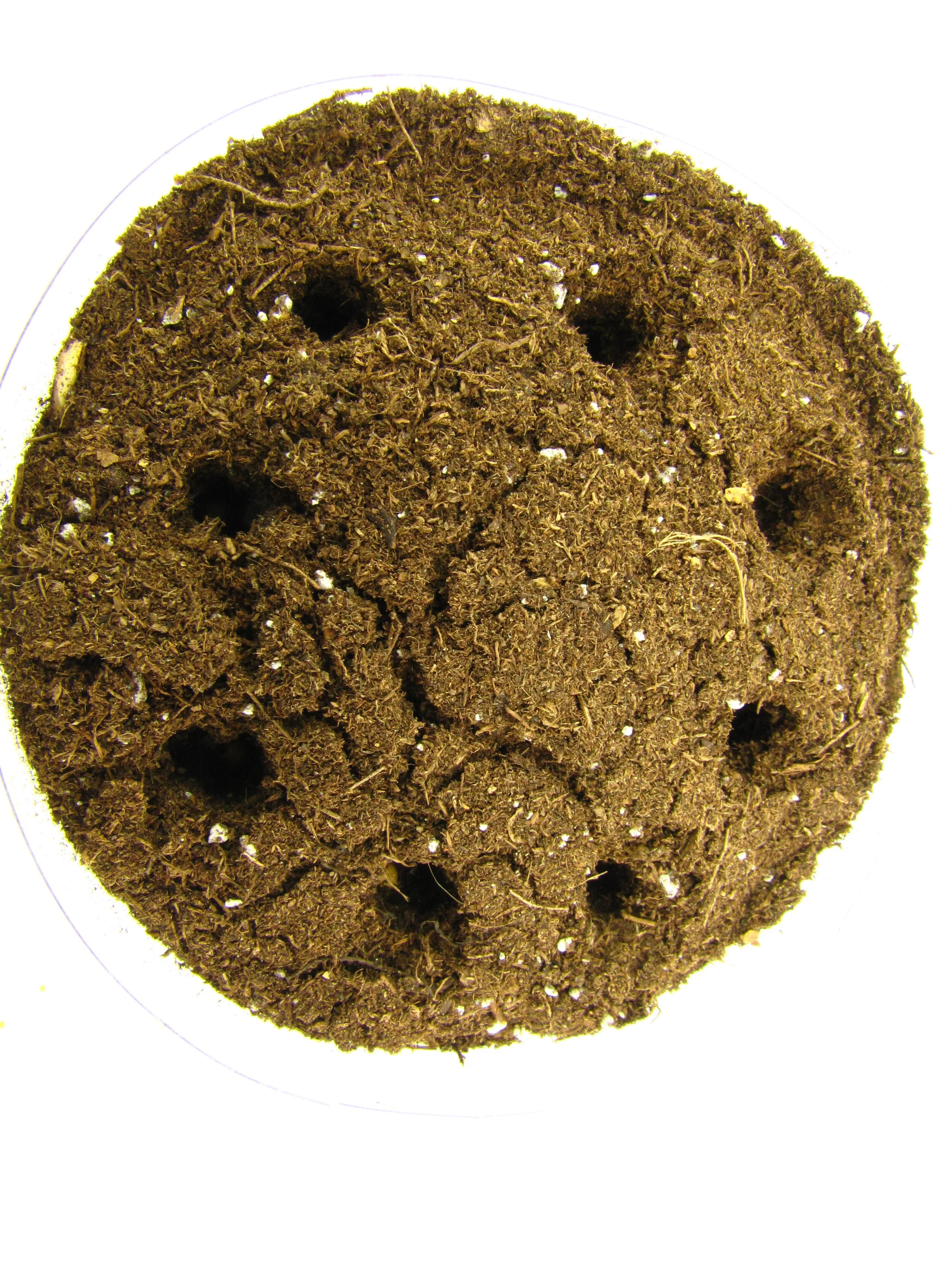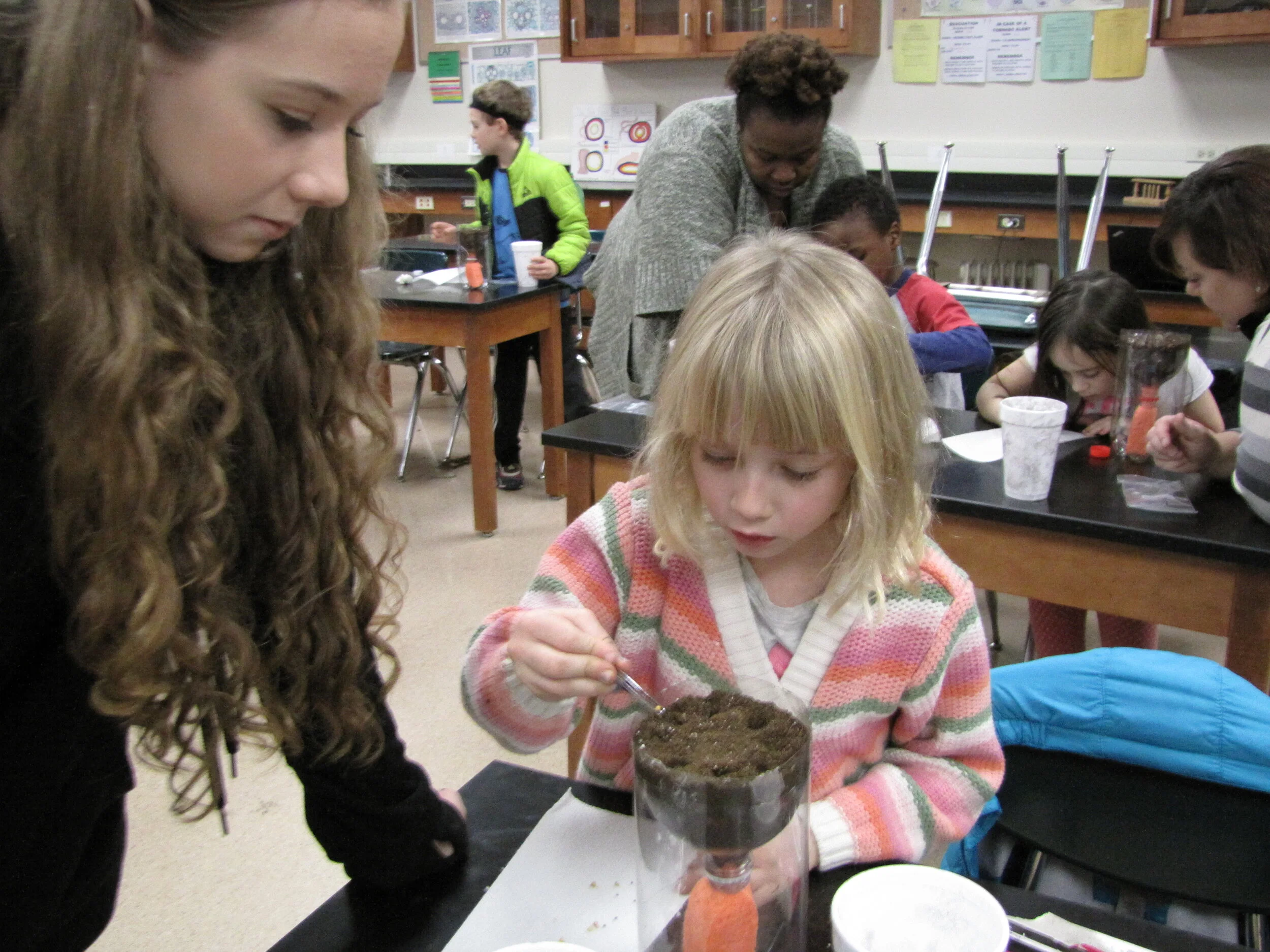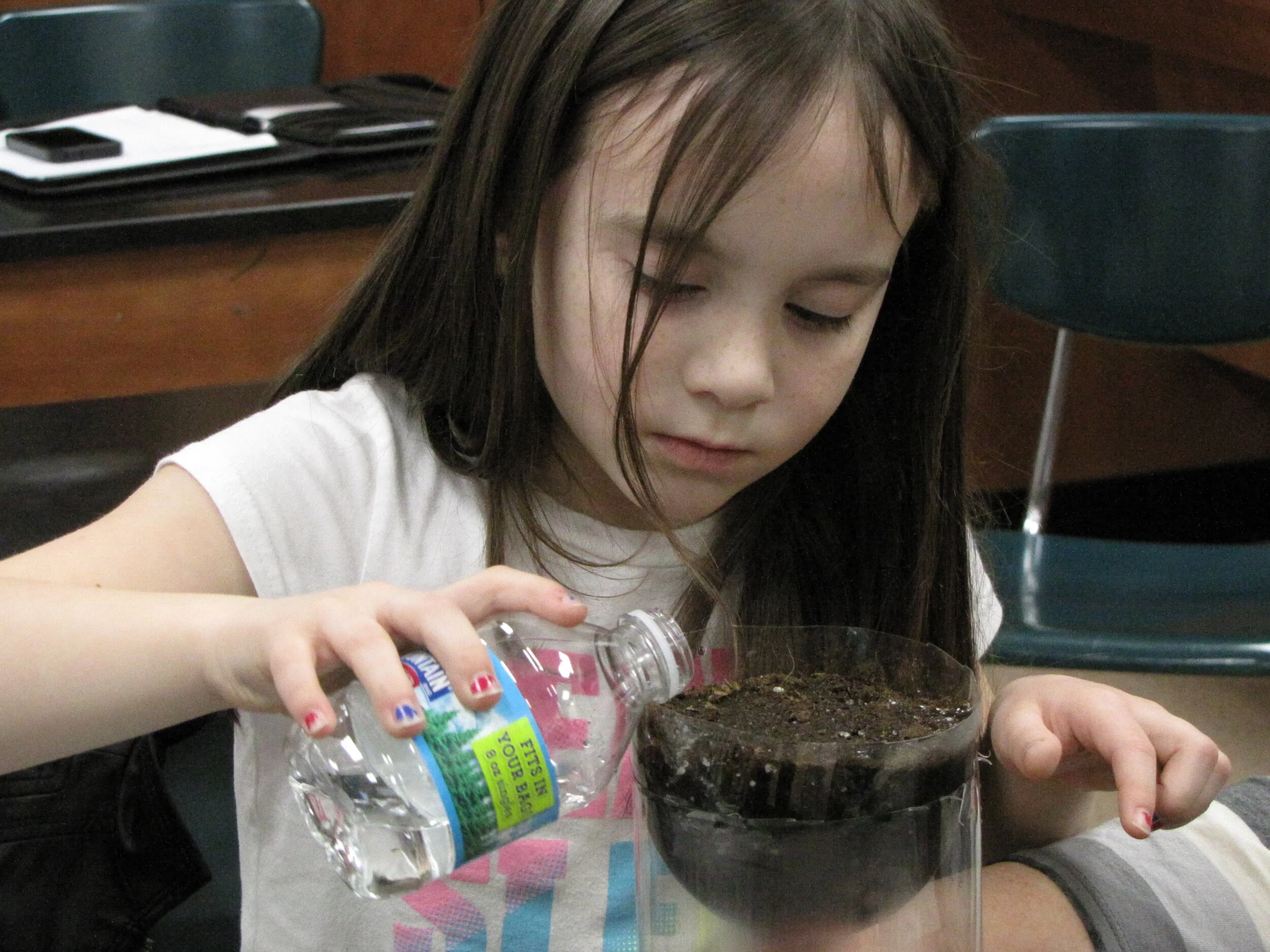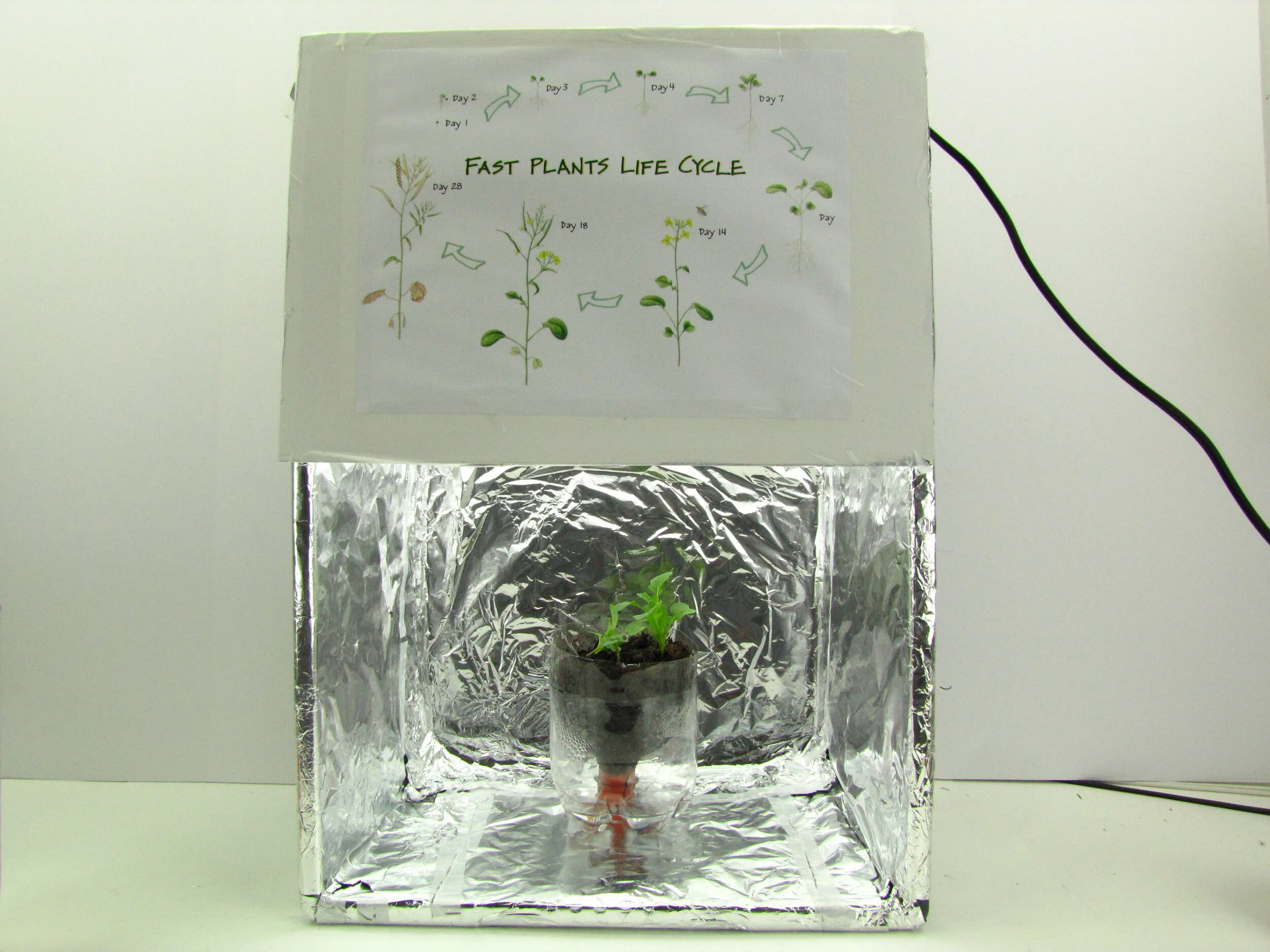The sponge used to make the wick was 1.25 inches thick, 4.25 inches wide, and 7.0 inches tall. The sponge was cut length wise1.25 inches from the edge to make a 1.25 inch X 1.25 inch X 7.0 inch piece. That piece was inserted through the neck extending halfway up into the bowl area.
Eight Holes Were Dug into the Planter Soil
Potting soil was placed in the top half of the planter and eight holes were dug into the soil about ½ inch deep and 60 degrees apart using a pencil. Assuming that the germination rate will not be 100%, more than one seed was put into each well, three in fact. Eight holes with 3 seeds would make 24 plants growing out of the planter if the germination rate was 100%.
Place Three Seeds Into Each Hole
Add a Bead of Osmocote Fertilizer to Each Hole to Provide Micronutrients.
Light from the lamp, carbon dioxide from the air, and water from the planter provide the three primary foods that the plants need to grow. Lesser nutrients also provide life to the plant like nitrogen, phosphate, and potassium from fertilizer like Osmocote. Plant micronutrients are analogous to human vitamins and minerals --- without them, plants usually keep growing, but they often grow slower or have problems.
Making the Planters and Planting the Seeds Takes about Two Hours
The first 2-hr class consisted of making the planter out of a precleaned 2-L soda bottle, filling the planter with soil, and adding the seeds and fertilizers beads. The task can be done by 6-year old's with teenage or adult supervision. Young child love the wonder of growing plants. www.supersaturday.org
Start the Germination by Watering the Soil
Germination starts with the addition of water to the planter. The soil was thoroughly soaked with water by pouring drinking water from a 12 oz bottle into the planter. In a way this was anticlimactic since nothing happens. It would take days for the seeds to germinate and the first leaves to emerge. Students need to keep in mind to put the plant under a lamp when they get home and daily observe the plant.
The Cotyledon or "seed leaf" formed during the first week
The growth of the Fast Plant starts out slow enough that the lightbox can be built the second week 2-hr class. However, the plant still will need light the first week provided by a desk lamp. So, find a table or dest lamp and put the planter under 24 hours light.
Week 2: Make the Fast Plant Light
The light box was built during the second 2-hour class period by the students with the help from adults. The box was made out of plastic storage crate lined with aluminum foil. A lamp hung from the top with a 100W fluorescent bulb. This class was labor intensive. All the materials were supplied, but it still took every minute of the 2-hour class to complete the project. The light boxes were taken home.
The Light Box Materials Cost About $36 and Takes Two Hours of Work to Make
How to Make a Fast Plant Light Box Video
Step by step slide show making a Wisconsin Fast Plant light box.
Week 2: True Leaves Form after Cotyledon
First the cotyledon or embryonic leaves form and they obtain their food from the embryo. Secondly, the true leaves form obtaining food from the young plant. The true leaf contains all the leaf structure parts, the most obvious being the veins.
http://sciencewithme.com/wp-content/uploads/2015/04/leaf_part_names1.jpg
The Plant Family Name “Cruciferous” Comes from the Word Crucifix, because the Leaves Grow across from Each Other
In this picture, the first true leaves grew 90 degrees across from the cotyledon, and the second true leaves 90 degree across from the previous. A defining characteristic of fast plants is that each layer of leaves grow across from the last. Thus, the Fast Plant belongs to a family of plants call Cruciferous plants. The common name Cruciferous comes from the word cross or crucifix. The scientific name for Cruciferous plants is Brassica. The scientific name for the Fast Plant is Brassica Rapa. Note, the flower head started to form on the plant.
Photosynthesis
One of the most important concepts to discuss is that of photosynthesis. This amazing process powers every life form on the planet directly or indirectly. Photosynthesis occurs in the leaves where chloroplasts uses the energy of light to combine carbon dioxide and water to form carbohydrates. Carbohydrates are formed as digestible and indigestible form. Cellulose is indigestible and edible food products are digestible carbohydrates. See references
Photosynthesis song https://www.youtube.com/watch?v=wj8TGhcCnxs
https://sciencing.com/photosynthesis-place-5481899.html
Fast Plants Life Cycle
This is a picture of the Fast Plants Life Cycle as found at the website below. However, note that it was divided into four weeks.
Week 1 Germination: Days 0-2
Week 2 Growth and Development: Days 3-12
Week 3 Flowering: Days13-15
Pollination: Days 15-17
Weeks 4 Seed Development and Harvest: Days 18-35
fastplants.org/wp-content/uploads/2017/03/Fast-Plant-Life-Cycle.jpg
The Standard Fast Plant Grew to 15+ cm in Height
The Standard Fast Plant grew too tall for this light box and planter reaching to top. The Standard Fast Plant is advertised to reach the height of 15 cm (9.8 in). The height of the light box was 49.5 cm and the height of the planter was 20 cm. So the plant grew to 19.5 cm, not the advertised 15 cm. Since the plant grew past the light bulb, the lighting was not the most effective. So the next model of the light box, we used a variant of the plant called Petite that was advertise to reach only 7 cm, and the light bulb was raised to almost flush to the top.
The Petite Fast Plant Mutation
The Petite plant was a mutant that had the advantage of being shorter and thus the plant seeds were kept because of those characteristics.
http://www.fastplants.org/pdf/seedstocks/petite.pdf
Light Box Redisigned for the Petite Fast Plant
The smaller Petite Fast Plant was compatible with this light box and planter. The Petite Fast Plant is advertised to reach the height of 7 cm (9.8 in). The height of the light box was 49.5 cm, the bulb drops down 3 cm, and the height of the planter was 20 cm leaving 26.5 cm for the Petite plant. It is expected that this will provide a better arrangement for experimenting.














![8214db8d-b47a-4bf7-871f-ceb5ed4767bc_1.84100e50ceca35ef65e740d884c66d34[1].jpg](https://images.squarespace-cdn.com/content/v1/546d2dc8e4b0a75239544203/1571704673839-VEOVXKRRBX9RBWEZRFCT/8214db8d-b47a-4bf7-871f-ceb5ed4767bc_1.84100e50ceca35ef65e740d884c66d34%5B1%5D.jpg)
